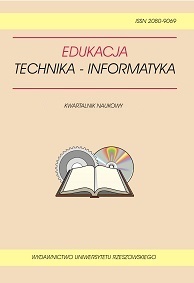Student Use of Mobile Devices in University Classes
DOI:
https://doi.org/10.15584/eti.2016.2.27Słowa kluczowe:
educational technology, Mobile devices, University teachingAbstrakt
Computer technologies are widely used by students of any level of education. In the broad range of computer hardware mobile devices deserve special attention. They offer a number of benefits to students including the possibility of making editable notes, searching for information on line, communicating quickly and effectively or accessing multimedia materials. Due to the size of those devices the students can easily use them during classes. The study reported was done on a relatively large group of students (503) from students of the Faculty of Production Engineering of the University of Life Sciences in Lublin, Poland. Its main goal was to establish students’ use of mobile devices in the educational processes, and in particular during formal classes (lectures, tutorials and lab experiments). The key finding was that above 90% of students used mobile devices during classes. The most popular mobile device was a notebook (used by 80% of students), followed by a smartphone (71%) and tablet (17%). The most popular activity was making calculations related to attended courses.Pobrania
Opublikowane
2016-06-30
Jak cytować
LORENCOWICZ, E., KOCIRA, S., KOSZEL, M., & UZIAK, J. (2016). Student Use of Mobile Devices in University Classes. Journal of Education, Technology and Computer Science, 16(2), 206–219. https://doi.org/10.15584/eti.2016.2.27
Numer
Dział
PROBLEMY EDUKACJI INFORMATYCZNO-INFORMACYJNEJ
Licencja
Prawa autorskie (c) 2016 Journal of Education, Technology and Computer Science

Utwór dostępny jest na licencji Creative Commons Uznanie autorstwa – Na tych samych warunkach 4.0 Miedzynarodowe.

